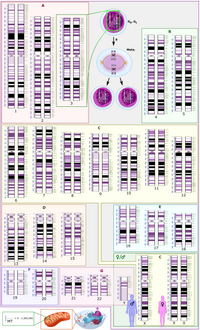
Photo from wikipedia
BACKGROUND Gastric cancer (GC), a multifactorial disease, is caused by pathogens, such as Helicobacter pylori (H. pylori) and Epstein-Barr virus (EBV), and genetic components. AIM To investigate microbiomes and host… Click to show full abstract
BACKGROUND Gastric cancer (GC), a multifactorial disease, is caused by pathogens, such as Helicobacter pylori (H. pylori) and Epstein-Barr virus (EBV), and genetic components. AIM To investigate microbiomes and host genome instability by cost-effective, low-coverage whole-genome sequencing, as biomarkers for GC subtyping. METHODS Samples from 40 GC patients were collected from Taizhou Hospital, Zhejiang Province, affiliated with Wenzhou Medical University. DNA from the samples was subjected to low-coverage whole-genome sequencing with a median genome coverage of 1.86 × (range: 1.03 × to 3.17 ×) by Illumina × 10, followed by copy number analyses using a customized bioinformatics workflow ultrasensitive chromosomal aneuploidy detector. RESULTS Of the 40 GC samples, 20 (50%) were found to be enriched with microbiomes. EBV DNA was detected in 5 GC patients (12.5%). H. pylori DNA was found in 15 (37.5%) patients. The other 20 (50%) patients were found to have relatively higher genomic instability. Copy number amplifications of the oncogenes, ERBB2 and KRAS, were found in 9 (22.5%) and 7 (17.5%) of the GC samples, respectively. EBV enrichment was found to be associated with tumors in the gastric cardia and fundus. H. pylori enrichment was found to be associated with tumors in the pylorus and antrum. Tumors with elevated genomic instability showed no localization and could be observed in any location. Additionally, H. pylori-enriched GC was found to be associated with the Borrmann type II/III and gastritis history. EBV-enriched GC was not associated with gastritis. No statistically significant correlation was observed between genomic instability and gastritis. Furthermore, these three different molecular subtypes showed distinct survival outcomes (P = 0.019). EBV-positive tumors had the best prognosis, whereas patients with high genomic instability (CIN+) showed the worst survival. Patients with H. pylori infection showed intermediate prognosis compared with the other two subtypes. CONCLUSION Thus, using low-coverage whole-genome sequencing, GC can be classified into three categories based on disease etiology; this classification may prove useful for GC diagnosis and precision medicine.
Journal Title: World Journal of Gastrointestinal Oncology
Year Published: 2022
Link to full text (if available)
Share on Social Media: Sign Up to like & get
recommendations!